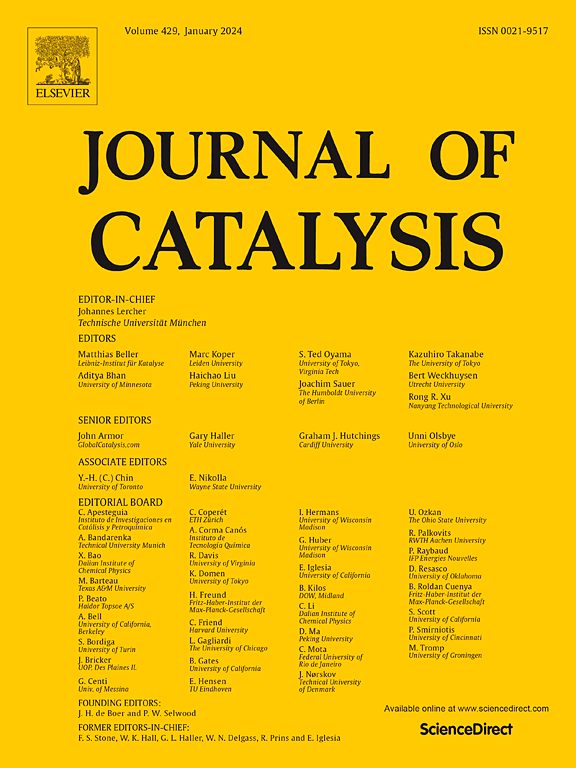The structure dependency of the activity and stability of Pd-phosphide catalysts in propane dehydrogenation
IF 6.5
1区 化学
Q2 CHEMISTRY, PHYSICAL
引用次数: 0
Abstract
A large number of alloy nanoparticle catalysts with novel configurations and compositions have been reported for efficient propane dehydrogenation. Although efforts have been made to rejuvenate the spent catalysts, the recovery of these well-defined active sites is still a daunting challenge. In this work, silica supported palladium-phosphide nanoparticles, with uniform particle sizes (∼2.5 nm) and specific crystal structures were prepared and systematically characterized. The combined structure analysis reveals that the exposed Pd site changes from metal Pd surface to few-atom Pd ensembles and fully isolated Pd atoms with gradually increasing P content. For identical reaction conditions of propane dehydrogenation, both the clustered Pd atoms and isolated Pdδ+ atoms exhibited dehydrogenation rates that is >10 times higher than the corresponding rate over Pd nanoparticle. Kinetic measurements demonstrated that the clustered Pd atoms on the surface of Pd3P nanoparticle shows the highest activity for C–H activation, while its also favored by coke deposition, leading to a trade-off relationship between activity and stability. By contrast, the Pd atoms on PdP2 surface exhibited a compromised dehydrogenation performance. Based on the deactivation mechanism of Pd-phosphide catalyst during dehydrogenation/regeneration cycles, an effective regeneration method, washing catalyst bed with alkaline-ethanol under mild conditions, was developed to remove deposited coke around dehydrogenation sites without sintering of nanoparticles. The structure–activity/stability relationship insights and facile regeneration method for the binary catalysts in this work offer improved knowledge of propane dehydrogenation catalyst.

磷酸钯丙烷脱氢催化剂活性和稳定性的结构依赖性
大量具有新型结构和成分的合金纳米颗粒催化剂已被报道用于丙烷的高效脱氢。虽然已经努力使废催化剂恢复活力,但这些明确的活性位点的恢复仍然是一个艰巨的挑战。在这项工作中,二氧化硅负载的磷化钯纳米颗粒,具有均匀的粒径(~ 2.5 nm)和特定的晶体结构,并被系统地表征。组合结构分析表明,随着P含量的逐渐增加,暴露的Pd位点由金属Pd表面转变为少原子Pd系综和完全隔离的Pd原子。在相同的丙烷脱氢反应条件下,聚簇Pd原子和分离Pdδ+原子的脱氢速率都比Pd纳米粒子上的相应速率高10倍。动力学测量表明,Pd3P纳米颗粒表面聚集的Pd原子对碳氢化合物的活化活性最高,同时也有利于焦沉积,导致活性和稳定性之间的权衡关系。相比之下,PdP2纳米颗粒表现出较差的脱氢性能。基于pd -磷化物催化剂在脱氢/再生过程中的失活机理,研究了一种有效的再生方法,即在温和条件下用碱-乙醇洗涤催化剂床层,在不烧结纳米颗粒的情况下去除脱氢部位周围沉积的焦炭。本工作对二元催化剂的构效稳定性关系的认识和易再生方法为丙烷脱氢催化剂提供了新的认识。
本文章由计算机程序翻译,如有差异,请以英文原文为准。
求助全文
约1分钟内获得全文
求助全文
来源期刊

Journal of Catalysis
工程技术-工程:化工
CiteScore
12.30
自引率
5.50%
发文量
447
审稿时长
31 days
期刊介绍:
The Journal of Catalysis publishes scholarly articles on both heterogeneous and homogeneous catalysis, covering a wide range of chemical transformations. These include various types of catalysis, such as those mediated by photons, plasmons, and electrons. The focus of the studies is to understand the relationship between catalytic function and the underlying chemical properties of surfaces and metal complexes.
The articles in the journal offer innovative concepts and explore the synthesis and kinetics of inorganic solids and homogeneous complexes. Furthermore, they discuss spectroscopic techniques for characterizing catalysts, investigate the interaction of probes and reacting species with catalysts, and employ theoretical methods.
The research presented in the journal should have direct relevance to the field of catalytic processes, addressing either fundamental aspects or applications of catalysis.
 求助内容:
求助内容: 应助结果提醒方式:
应助结果提醒方式:


